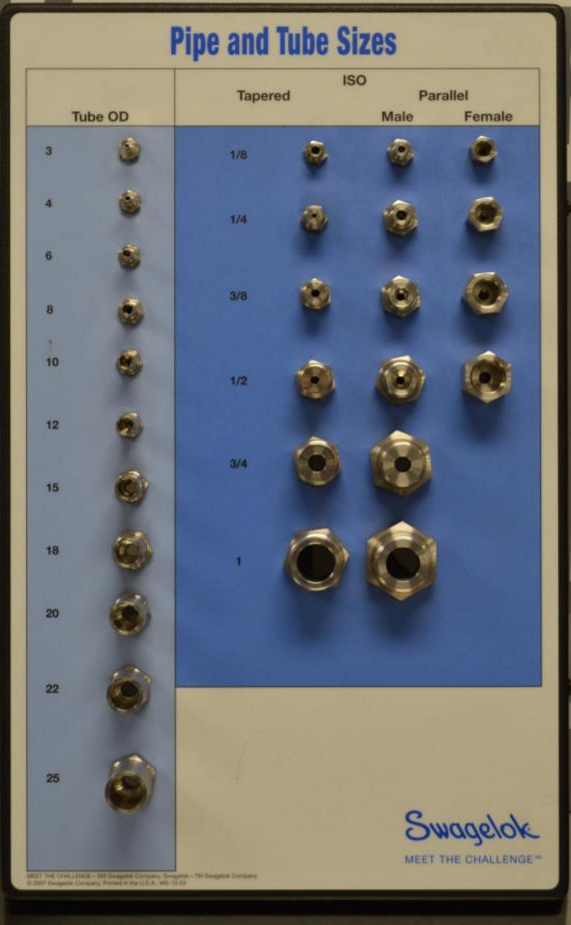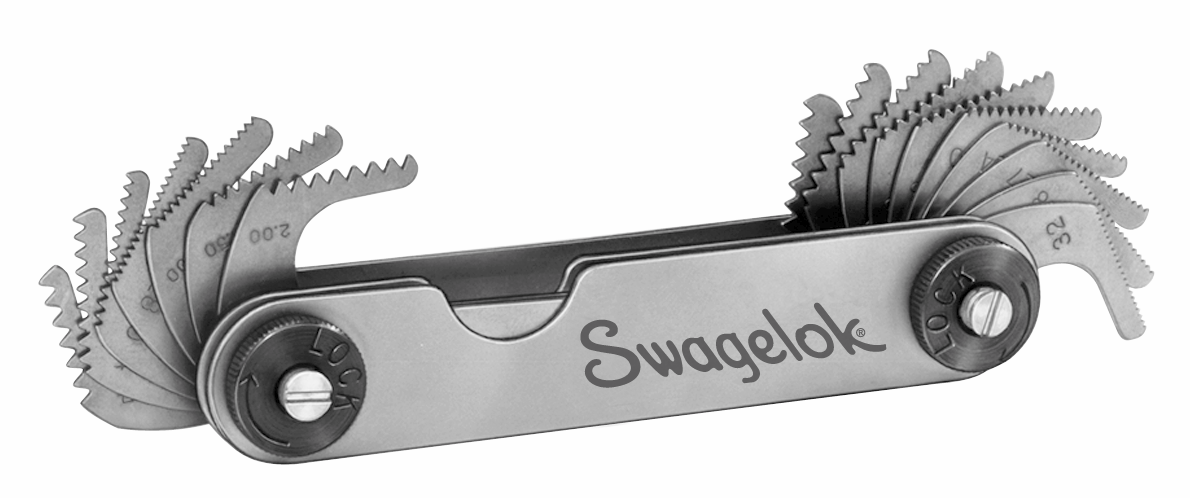Share this
Calipers, Combs, And Guides Help Make Sense of Threads
by Alecia Robinson on Thu, Nov 09, 2017 @ 12:11 PM
Scratching your head about threads? We have three tools that solve the mystery
 |
|
| The Pipe and Tube Sizes board (pictured above) is at our back counter. Bring in your fittings and we can help determine the sizing. | |
 |
|
| The thread pitch gauge is another tool we use to help with thread size - it's even available for purchase! To get more info on sizing, download the Thread and End Connection ID Guide PDF. |
Can you tell the thread size and thread pitch on a component just by looking at it? Neither can we. That's why we have tools that eliminate the guesswork.
When you look at a thread, you'll see peaks (called crests) and valleys (called roots). The part in between the crest and the root is called the flank. The first thing you want to find out is whether the crests are all the same diameter. That would mean you have straight threads. So we get out our calipers and measure the first, fourth and last crests. If the measurements are the same, you have straight threads. If you get three different measurements, you have tapered threads.
There's another way to tell, provided that you are working with Swagelok parts. Other than standard NPT, Swagelok fittings are uniquely marked to indicate ISO tapered or ISO parallel threads.
Some people are surprised to learn that straight threads are not designed to seal on their own. They require a gasket, O-ring or some kind of metal-to-metal contact to finish the job.
Tapered threads are designed to seal as the mating threads are drawn together. In addition, some kind of sealant is necessary to prevent leaks. That's usually PTFE tape or a product such as SWAK.
Here comes the "pitch"
Next you need to know how close together the crests are. That's the pitch, usually expressed as the number of threads per inch.
Straight threads come in three standard kinds of measurements. The most common are SAE (Society of Automotive Engineers), ISO 228/1 (also known as British Standard Pipe Parallel), and metric. Tapered threads also have several standard forms of measurement: NPT (National Pipe Thread), ISO 7/1 (also known as British Standard Pipe), and metric.
The flanks can come in different angles, known as Whitworth, unified, or metric.
To discover the pitch, we use a thread comb, also known as a pitch gauge. It looks a bit like a pocketknife, but the blades have saw-tooth edges that fit into the thread roots. We simply try different blades until we find an exact match. Some fractional and metric thread forms are very similar, so we take the time to make sure it's a true fit.
You also can turn to the Swagelok Thread and End Connection Identification Guide, which you can download for free. It has all the terminology, thread ID reference tables, and step-by-step instructions for identifying threads.
Lastly, Edmonton Valve & Fitting has a board with various sizes of threads. If you come in with a part, we can see which sample it fits.
Obviously, the threads on two parts have to have the same size and type of threads if you want to connect them. But you don't have to guess. Check in with Edmonton Valve & Fitting and we'll work with you to get the right answer. Give us a call at 780.437.0640 or get in touch below.
Share this
- Local Services (103)
- Field Advisors (101)
- Training & Events (86)
- Fittings (81)
- Valves (67)
- Resources (62)
- Tubing (62)
- Sampling Systems (60)
- Design & Assembly (57)
- Resources - Downloads (41)
- Hose & Flexible Tubing (39)
- Frequently Asked Questions (37)
- Regulators (34)
- Cost Savings (33)
- Oil & Gas (33)
- Videos (33)
- Steam Systems (29)
- Mechanical Seal Support (17)
- Measurement Devices (15)
- Gas Distribution Systems (9)
- Rentals (6)
- Safety (6)
- winterization (6)
- Covid (3)
- Hydrogen & Clean Energy (3)
- About Us (1)
- April 2024 (4)
- March 2024 (2)
- January 2024 (3)
- December 2023 (2)
- November 2023 (3)
- October 2023 (2)
- September 2023 (3)
- August 2023 (3)
- July 2023 (3)
- June 2023 (2)
- May 2023 (4)
- April 2023 (2)
- March 2023 (2)
- February 2023 (3)
- January 2023 (2)
- December 2022 (1)
- November 2022 (1)
- October 2022 (2)
- September 2022 (5)
- August 2022 (3)
- July 2022 (6)
- June 2022 (4)
- May 2022 (3)
- April 2022 (1)
- March 2022 (2)
- February 2022 (3)
- January 2022 (4)
- December 2021 (4)
- November 2021 (6)
- October 2021 (3)
- September 2021 (5)
- August 2021 (9)
- July 2021 (5)
- June 2021 (7)
- May 2021 (7)
- April 2021 (4)
- March 2021 (3)
- February 2021 (3)
- January 2021 (2)
- December 2020 (3)
- November 2020 (3)
- October 2020 (2)
- September 2020 (3)
- August 2020 (3)
- July 2020 (3)
- June 2020 (3)
- May 2020 (3)
- April 2020 (2)
- March 2020 (3)
- February 2020 (3)
- January 2020 (3)
- December 2019 (2)
- November 2019 (3)
- October 2019 (3)
- September 2019 (2)
- August 2019 (3)
- July 2019 (2)
- June 2019 (2)
- May 2019 (3)
- April 2019 (3)
- March 2019 (3)
- February 2019 (2)
- January 2019 (3)
- December 2018 (2)
- November 2018 (2)
- October 2018 (4)
- September 2018 (2)
- August 2018 (3)
- July 2018 (3)
- June 2018 (2)
- May 2018 (4)
- April 2018 (3)
- March 2018 (3)
- February 2018 (3)
- January 2018 (4)
- December 2017 (1)
- November 2017 (4)
- October 2017 (4)
- September 2017 (4)
- August 2017 (5)
- July 2017 (3)
- June 2017 (4)
- May 2017 (4)
- April 2017 (3)
- March 2017 (5)
- February 2017 (4)
- January 2017 (4)
- December 2016 (3)
- November 2016 (3)
- October 2016 (4)
- September 2016 (3)
- August 2016 (4)
- July 2016 (2)
- June 2016 (2)
- May 2016 (2)
- April 2016 (4)
- March 2016 (2)
- February 2016 (3)
- January 2016 (4)
- December 2015 (4)
- November 2015 (4)
- October 2015 (5)
- September 2015 (2)
- August 2015 (4)
- July 2015 (5)
- June 2015 (2)
- May 2015 (3)
- April 2015 (5)
- March 2015 (3)
- February 2015 (4)
- January 2015 (3)
- December 2014 (5)
- November 2014 (4)
- October 2014 (4)
- September 2014 (4)
- August 2014 (4)
- July 2014 (5)
- June 2014 (4)
- May 2014 (4)
- April 2014 (5)
- March 2014 (4)
- February 2014 (4)
- January 2014 (4)
- December 2013 (3)
- November 2013 (4)
- October 2013 (5)
- September 2013 (4)
- August 2013 (5)
- July 2013 (4)
- June 2013 (3)
- May 2013 (4)
- April 2013 (5)
- March 2013 (2)
- February 2013 (3)
- January 2013 (5)
- December 2012 (3)
- November 2012 (3)
- October 2012 (5)
- September 2012 (3)
- August 2012 (4)
- July 2012 (4)
- June 2012 (1)



